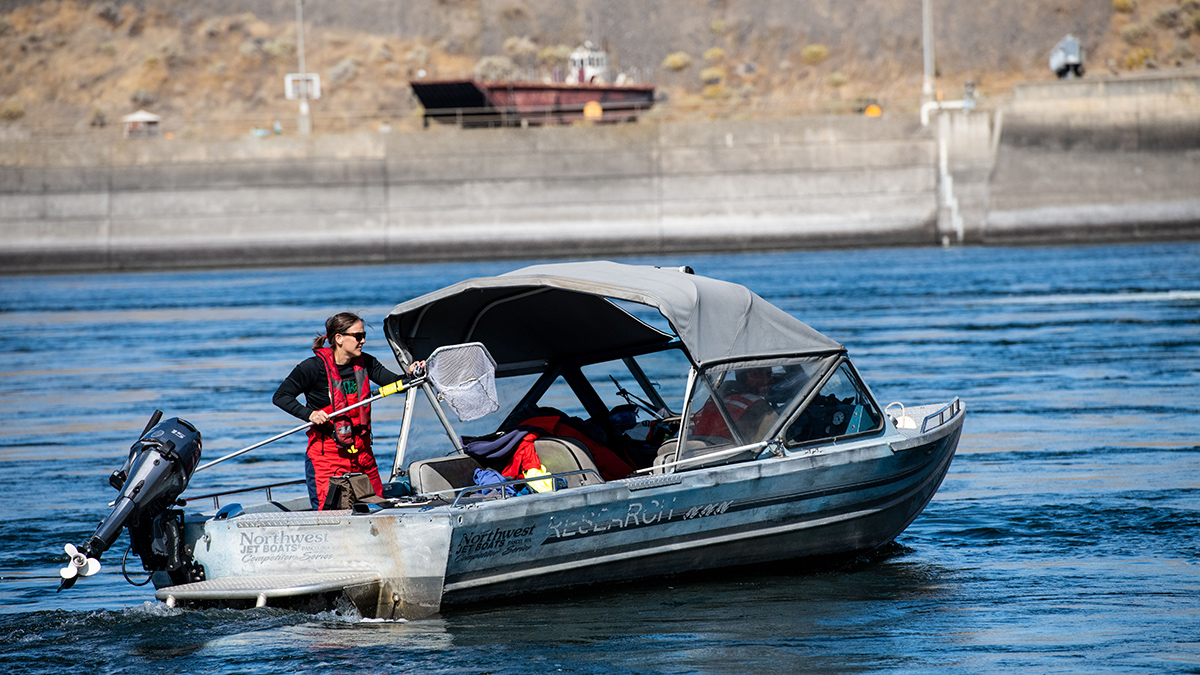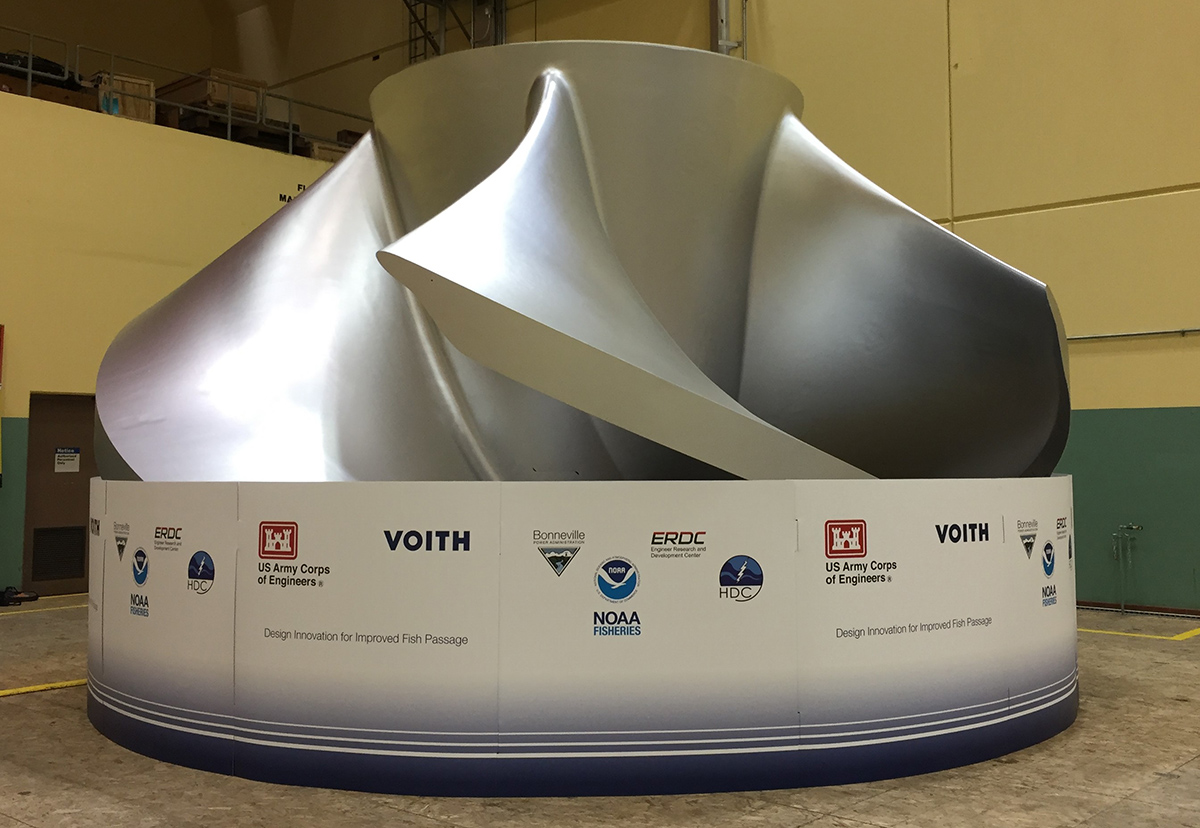2020-03-03 Preliminary field test results demonstrate Ice Harbor turbine manufactured by Voith achieves high fish passage survival rates
- Chinook salmon demonstrate a 98.25% fish passage survival rate in the preliminary tests.
- The new turbine design also achieved a 4% boost in hydraulic efficiency.
- The success of the updated design was the result of excellent collaboration between Voith, the United States Army Corps of Engineers (USACE), the National Marine Fisheries Service (NMFS) and the Bonneville Power Administration (BPA).

PNNL researchers retrieve the Sensor Fish after they’ve traveled through Ice Harbor dam, which features the new Voith turbine. (Photo Credit: Andrea Starr | Pacific Northwest National Laboratory)
BURBANK, Wash. / YORK, Pa. (March 2, 2020) – Preliminary testing on a new turbine installed at the Ice Harbor Dam on the Snake River in Washington state shows the new design has achieved a survival rate of 98.25% for fish passing through the turbine. This is a significant improvement over similarly sized conventional Kaplan turbine installations in the industry, which typically see survival rates in the low 90 percent range.
One of the primary goals of the new Unit 2 turbine design was to improve the fish passage survival rate, and this milestone was accomplished while simultaneously increasing the turbine’s hydraulic performance and extending the life cycle of the unit.
“This was a truly collaborative effort between BPA, USACE, NMFS and Voith, a proven industry leader with decades of experience in this type of technology, and the only large hydropower manufacturing facility still in the United States,” explained Stanley Kocon, President and CEO, Voith Hydro North America. “Together, this team looked at the results of the modeling and designed a propeller turbine based on what was safest for the Snake River’s Chinook salmon fish population. This is a significant step in protecting this and other species, such as steelhead, while also continuing to serve the renewable electricity needs of the Pacific Northwest.”
The testing was conducted in late 2019 with the Voith-manufactured turbine that had been installed earlier that summer. To perform the test, the Pacific Northwest National Laboratory (PNNL) released “sensor fish” devices within the turbine intakes to collect pressure and acceleration data during operation.
Also part of the testing was the release of live juvenile Chinook salmon equipped with balloon-tags to aide in the recovery process. After release, each fish was then examined following passage downstream through the turbine.
Analysis of the preliminary results of these tests showed a high rate of direct survival for migrating juvenile salmonids as they passed through Unit 2, satisfying a key goal of the modernization project.

Designing and manufacturing the turbine
For Voith, the project began in 2010 when the manufacturer was awarded the contract by the USACE. After a multi-year design period, manufacturing at its Pennsylvania facility began. Installation and commissioning on the propeller turbine was complete in the summer of 2019.
“The collaboration involved in this project is what made it succeed,” said Jason Foust, Hydraulic Design Engineer, Voith Hydro North America. “Utilizing a combination of detailed numerical simulations, physical model testing, and decades of hydro turbine experience, we created one of the most advanced turbines installed anywhere in the world right now for improving direct survival. All of our tools and knowledge were focused on achieving a high survival rate for migrating fish. We weren’t willing to compromise on any aspect of fish passage, and that meant that we had to develop innovative solutions. Through the process, we also boosted the turbine’s hydraulic efficiency, improved cavitation behavior and increased the turbine life cycle, making this project an incredible success.”
Another Voith turbine, a Kaplan with adjustable blades designed by the same team using the same fish-passage evaluation process, is currently being installed at the site, and is expected to undergo similar testing once it is commissioned.
Ice Harbor is located about eight miles northeast of Burbank, Washington, and is one of four dams on the Lower Snake River under USACE operation. Improving the fish passage rates at each dam is a critical need as it allows more juvenile fish to migrate downstream after hatching while also maintaining the high renewable energy generation capabilities for the region. Ice Harbor Dam is a concrete gravity run-of-river renewable energy facility that began operation in 1962 and has a generating capacity of 603 megawatts.
About the company

The Voith Group is a global technology company. With its broad portfolio of systems, products, services and digital applications, Voith sets standards in the markets of energy, oil & gas, paper, raw materials and transport & automotive. Founded in 1867, the company today has more than 19,000 employees, sales of € 4.3 billion and locations in over 60 countries worldwide and is thus one of the larger family-owned companies in Europe.
read more
The Group Division Voith Hydro is part of the Voith Group and a leading full-line supplier as well as trusted partner for equipping hydropower plants. Voith develops customized, long-term solutions and services for large and small hydro plants all over the world. Its portfolio of products and services covers the entire life cycle and all major components for large and small hydro plants, from generators, turbines, pumps and automation systems, right through to spare parts, maintenance and training services, and digital solutions for intelligent hydropower.
more about hydropower